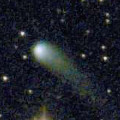
|
Now it is 11.0 mag (Nov. 1, Seiichi Yoshida). It is expected to brighten up to 8 mag in 2020. It stays observable in good condition for a long time in the Northern Hemisphere. In the Southern Hemisphere, it will be unobservable soon. Then it is not observable until July.
Date(TT) R.A. (2000) Decl. Delta r Elong. m1 Best Time(A, h)
Nov. 16 5 22.59 40 34.7 1.838 2.716 146 10.4 1:46 (180, 85)
Nov. 23 5 12.10 43 14.6 1.740 2.650 151 10.2 1:08 (180, 82)
|
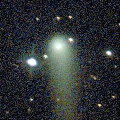
|
Now it is 11.5 mag (Nov. 1, Seiichi Yoshida). It stays bright as 11 mag until winter. It stays observable in good condition for a long time in the Northern Hemisphere. In the Southern Hemisphere, it will be unobservable soon. Then it will never be observable again.
Date(TT) R.A. (2000) Decl. Delta r Elong. m1 Best Time(A, h)
Nov. 16 0 11.81 38 58.6 2.355 3.125 134 11.3 20:30 (180, 86)
Nov. 23 23 59.93 39 6.7 2.430 3.127 127 11.4 19:51 (180, 86)
|
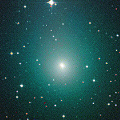
|
It brightened up to 8.3 mag in September (Sept. 20, Maik Meyer). Now it is fading. But it is still bright as 11.1 mag (Nov. 2, Chris Wyatt). In the Southern Hemisphere, it stays observable for a long time after this. In the Northern Hemisphere, it will be unobservable in early December.
Date(TT) R.A. (2000) Decl. Delta r Elong. m1 Best Time(A, h)
Nov. 16 21 34.36 -42 15.2 1.648 1.764 79 12.2 18:21 ( 5, 13)
Nov. 23 21 34.80 -43 19.3 1.838 1.820 73 12.6 18:19 ( 9, 11)
|
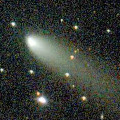
|
Now it is 11.7 mag (Nov. 4, Sandor Szabo). It will fade out rapidly after this. It is observable in excellent condition in the Northern Hemisphere. It stays locating extremely low in the Southern Hemisphere.
Date(TT) R.A. (2000) Decl. Delta r Elong. m1 Best Time(A, h)
Nov. 16 2 27.23 50 5.5 0.678 1.599 146 12.8 22:46 (180, 75)
Nov. 23 2 24.27 49 33.8 0.721 1.635 145 13.1 22:16 (180, 75)
|
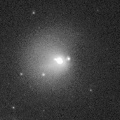
|
Now it is 14.5 mag (Nov. 4, Sandor Szabo).
Date(TT) R.A. (2000) Decl. Delta r Elong. m1 Best Time(A, h)
Nov. 16 0 27.17 13 42.7 5.009 5.779 137 13.2 20:47 ( 0, 69)
Nov. 23 0 25.89 13 26.8 5.090 5.780 130 13.2 20:18 ( 0, 69)
|
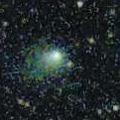
|
Now it is 13.9 mag (Oct. 26, Toshihiko Ikemura, Hirohisa Sato). It will be fading slowly after this.
Date(TT) R.A. (2000) Decl. Delta r Elong. m1 Best Time(A, h)
Nov. 16 20 10.39 -15 51.2 1.908 1.795 68 14.0 18:21 ( 32, 33)
Nov. 23 20 28.93 -15 32.5 1.966 1.800 65 14.1 18:19 ( 34, 32)
|

|
Now it is 14.2 mag (Nov. 2, Chris Wyatt). It will be fading slowly after this. In the Southern Hemisphere, it becomes low from February to March, but it stays observable for a long time. In the Northern Hemisphere, it is not observasble until summer in 2020.
Date(TT) R.A. (2000) Decl. Delta r Elong. m1 Best Time(A, h)
Nov. 16 20 31.61 -77 40.3 3.427 3.212 69 14.5 18:21 ( 5,-23)
Nov. 23 20 54.32 -74 40.8 3.492 3.233 66 14.6 18:19 ( 6,-20)
|
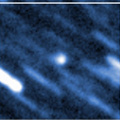
|
Now it is 14.8 mag (Oct. 30, Toshihiko Ikemura, Hirohisa Sato). It stays at 14.5-15 mag until December. It is observable in good condition in the Southern Hemisphere. It locates somewhat low in the Northern Hemisphere.
Date(TT) R.A. (2000) Decl. Delta r Elong. m1 Best Time(A, h)
Nov. 16 20 31.43 -17 42.3 1.819 1.794 72 14.7 18:21 ( 26, 33)
Nov. 23 20 46.69 -15 50.6 1.874 1.789 69 14.7 18:19 ( 29, 34)
|
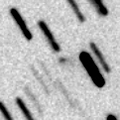
|
Now it is 15.3 mag (Nov. 5, Katsumi Yoshimoto). It will brighten very rapidly, and it will brighten up to 14 mag in winter. It is observable in excellent condition in the Northern Hemisphere. It locates low in the Southern Hemisphere.
Date(TT) R.A. (2000) Decl. Delta r Elong. m1 Best Time(A, h)
Nov. 16 2 12.72 43 22.1 0.753 1.688 151 14.9 22:32 (180, 82)
Nov. 23 2 11.79 41 9.5 0.734 1.665 150 14.8 22:04 (180, 84)
|

|
Now it is 16.3 mag (Nov. 2, Toshihiko Ikemura, Hirohisa Sato). It is fainter than this ephemeris recently.
Date(TT) R.A. (2000) Decl. Delta r Elong. m1 Best Time(A, h)
Nov. 16 9 29.94 7 39.7 2.469 2.671 90 14.8 5:07 (337, 61)
Nov. 23 9 34.16 7 2.2 2.406 2.703 96 14.9 5:13 (352, 62)
|

|
It brightened up to 7.7 mag in June in 2018 (June 19, Juan Jose Gonzalez). Now it is fading. It has already faded down to 15.1 mag (Nov. 6, Toshihiko Ikemura, Hirohisa Sato). In the Southern Hemisphere, it stays observable for a long time until the comet will fade out. In the Northern Hemisphere, it stays low for a while.
Date(TT) R.A. (2000) Decl. Delta r Elong. m1 Best Time(A, h)
Nov. 16 6 45.66 -34 27.0 4.858 5.254 108 14.8 3:08 ( 0, 21)
Nov. 23 6 39.94 -34 35.4 4.857 5.310 112 14.9 2:35 ( 0, 20)
|
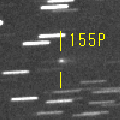
|
Now it is 15.4 mag (Nov. 1, Toshihiko Ikemura, Hirohisa Sato). It brightens rapidly, and it will be observable at 14.5 mag in good condition in winter. It locates somewhat low in the Southern Hemisphere.
Date(TT) R.A. (2000) Decl. Delta r Elong. m1 Best Time(A, h)
Nov. 16 9 54.03 14 49.8 1.550 1.802 87 15.1 5:07 (318, 65)
Nov. 23 10 9.03 14 5.0 1.494 1.804 90 14.9 5:13 (328, 66)
|
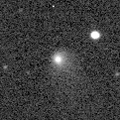
|
Now it is 14.6 mag (Oct. 18, Chris Wyatt). In the Southern Hemisphere, it is observable for a long time. It stays low in the Northern Hemisphere.
Date(TT) R.A. (2000) Decl. Delta r Elong. m1 Best Time(A, h)
Nov. 16 22 51.76 -34 4.6 4.402 4.625 96 15.2 19:12 ( 0, 21)
Nov. 23 22 51.89 -32 38.1 4.532 4.657 91 15.3 18:44 ( 0, 23)
|
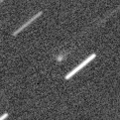
|
Now it is 15.6 mag (Nov. 6, Toshihiko Ikemura, Hirohisa Sato). The orbit is extremely hyperbolic with e=3.35. It is the first interstellar comet in history. It brightens up to 15 mag in December. In the Northern Hemisphere, it stays observable in good condition until early December. Then it will be getting lower, and it will be unobservable in mid January. In the Southern Hemisphere, it will be getting higher gradually. Then it will be observable in excellent condition.
Date(TT) R.A. (2000) Decl. Delta r Elong. m1 Best Time(A, h)
Nov. 16 10 49.67 -1 43.8 2.208 2.068 68 15.4 5:07 (315, 43)
Nov. 23 11 1.87 -6 39.3 2.125 2.036 71 15.2 5:13 (325, 42)
|
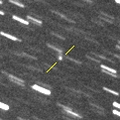
|
In the Southern Hemisphere, it is observable at 14.5 mag from winter to spring. In the Northern Hemisphere, it is not observable until August when it fades down to 17 mag.
Date(TT) R.A. (2000) Decl. Delta r Elong. m1 Best Time(A, h)
Nov. 16 15 47.94 -53 41.7 3.009 2.278 35 15.5 18:21 ( 42,-29)
Nov. 23 15 59.79 -55 45.2 2.968 2.240 35 15.4 18:19 ( 41,-32)
|

|
It has not been observed yet in this apparition. Now it is fainter than 21.5 mag (Aug. 4, Erwin Schwab). It was expected to brighten up to 12 mag from August to September. But actually, it must be much fainter than expected. It is observable in good condition in the Northern Hemisphere. It is not observable in the Southern Hemisphere.
Date(TT) R.A. (2000) Decl. Delta r Elong. m1 Best Time(A, h)
Nov. 16 7 38.47 59 21.5 1.072 1.777 119 15.6 4:01 (180, 66)
Nov. 23 7 35.68 60 37.7 1.078 1.824 123 16.2 3:31 (180, 64)
|
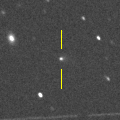
|
Now it is 14.8 mag (Nov. 4, Sandor Szabo). It stays 15-16 mag until December, and it is observable in good condition.
Date(TT) R.A. (2000) Decl. Delta r Elong. m1 Best Time(A, h)
Nov. 16 23 46.08 -8 55.0 1.745 2.397 119 15.8 20:06 ( 0, 46)
Nov. 23 23 49.54 -8 18.6 1.806 2.385 113 15.8 19:42 ( 0, 47)
|
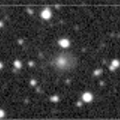
|
Now it is 15.0 mag (July 21, Taras Prystavski). It stays 16 mag for a long time from 2019 to 2020. It stays observable for a long time in the Southern Hemisphere. It is hardly observable in the Northern Hemisphere.
Date(TT) R.A. (2000) Decl. Delta r Elong. m1 Best Time(A, h)
Nov. 16 13 3.56 -76 30.1 3.820 3.444 60 15.8 5:07 (346,-28)
Nov. 23 13 25.84 -79 3.4 3.807 3.441 61 15.8 5:13 (349,-29)
|
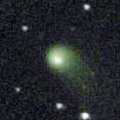
|
Now it is 14.8 mag (Aug. 28, Chris Wyatt). It will be fading slowly after this. In the Southern Hemisphere, it stays observable in good condition for a long time, although it becomes low from October to November. It will never be observable after this in the Northern Hemisphere.
Date(TT) R.A. (2000) Decl. Delta r Elong. m1 Best Time(A, h)
Nov. 16 14 13.01 -52 31.0 5.048 4.295 36 15.8 5:07 (319,-23)
Nov. 23 14 17.05 -53 46.3 5.069 4.336 38 15.9 5:13 (323,-20)
|
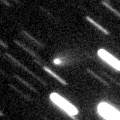
|
Now it is 15.3 mag (Nov. 4, Sandor Szabo). It is observable at 16 mag in good condition from October to November.
Date(TT) R.A. (2000) Decl. Delta r Elong. m1 Best Time(A, h)
Nov. 16 2 49.95 1 40.0 1.627 2.583 161 16.2 23:07 ( 0, 57)
Nov. 23 2 23.78 -1 1.3 1.709 2.610 149 16.3 22:13 ( 0, 54)
|
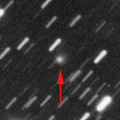
|
Now it is 16.2 mag (Oct. 4, Toshihiko Ikemura, Hirohisa Sato). It is expected to be observable at 5-6 mag for a long time from 2022 to 2023. In the Northern Hemisphere, it is not observable at the high light from 2022 summer to 2023 summer. In the Southern Hemisphere, it stays unobservable for a while. But it will be observable in good condition at the high light.
Date(TT) R.A. (2000) Decl. Delta r Elong. m1 Best Time(A, h)
Nov. 16 17 25.13 46 56.1 10.717 10.438 71 16.3 18:21 (126, 38)
Nov. 23 17 28.57 46 31.5 10.683 10.390 70 16.3 18:19 (126, 34)
|

|
It brighted rapidly from 20.5 mag up to 18.5 mag in September. It was 18.7 mag on Oct. 22 (Geisei Observatory). However, it was not detected, fainter than 19 mag, in late October. It will approaches to Earth down to 0.09 a.u. in early January. It will be obesrvable in excellent condition in the Northern Hemisphere. If it is as bright as in 2003, it will be 17.5 mag at best. But if it shows cometary activity, it may brighten up to 13.5 mag. In the Southern Hemisphere, it will not be observable at the high light.
Date(TT) R.A. (2000) Decl. Delta r Elong. m1 Best Time(A, h)
Nov. 16 22 22.16 -21 25.0 0.342 1.082 96 16.7 18:42 ( 0, 34)
Nov. 23 22 24.79 -19 14.8 0.313 1.040 90 16.3 18:19 ( 0, 36)
|
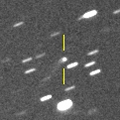
|
Now it is 15.8 mag (Oct. 5, Toshihiko Ikemura, Hirohisa Sato). It stays 15-16 mag for a long time until 2021.
Date(TT) R.A. (2000) Decl. Delta r Elong. m1 Best Time(A, h)
Nov. 16 20 1.73 -23 4.2 5.135 4.798 64 16.4 18:21 ( 31, 25)
Nov. 23 20 2.82 -22 8.7 5.225 4.778 58 16.4 18:19 ( 36, 24)
|
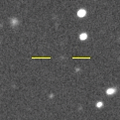
|
Now it is 17.4 mag (Nov. 3, Toshihiko Ikemura, Hirohisa Sato). It will brighten up to 13.5-14 mag from 2020 to 2021. It stays observable in good condition for a long time after this until 2020 summer.
Date(TT) R.A. (2000) Decl. Delta r Elong. m1 Best Time(A, h)
Nov. 16 12 18.53 13 24.1 4.140 3.671 55 16.6 5:07 (280, 37)
Nov. 23 12 25.92 12 55.9 4.037 3.653 60 16.4 5:13 (286, 42)
|

|
It looks cometary on the LCO (CTIO) image on Aug. 21. Now it is 16.2 mag (Oct. 2, ATLAS-MLO, Mauna Loa). It is observable in excellent condition in the Southern Hemisphere. In the Northern Hemisphere, it locates extremely low for a while.
Date(TT) R.A. (2000) Decl. Delta r Elong. m1 Best Time(A, h)
Nov. 16 19 45.45 -37 7.8 6.873 6.433 59 16.4 18:21 ( 27, 11)
Nov. 23 19 45.66 -36 34.2 6.980 6.436 53 16.5 18:19 ( 32, 9)
|
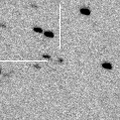
|
Now it is 16.7 mag (Oct. 4, Toshihiko Ikemura, Hirohisa Sato). It will brighten up to 10.5 mag from 2020 December to 2021 January. In the Northern Hemisphere, it stays observable in good condition while the comet will be brightening gradually, but it is not observable at the high light. In the Southern Hemisphere, it is not observable for a long time, but it will be observable in good condition after the high light.
Date(TT) R.A. (2000) Decl. Delta r Elong. m1 Best Time(A, h)
Nov. 16 16 56.85 63 51.8 4.666 4.675 84 16.5 18:21 (148, 37)
Nov. 23 17 4.33 62 56.7 4.603 4.612 84 16.5 18:19 (147, 35)
|
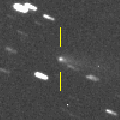
|
Now it is 17.1 mag (Oct. 31, Toshihiko Ikemura, Hirohisa Sato). It will be fading after this, and it will be fainter than 18 mag in late December.
Date(TT) R.A. (2000) Decl. Delta r Elong. m1 Best Time(A, h)
Nov. 16 3 23.64 27 43.9 1.336 2.318 170 16.7 23:42 ( 0, 83)
Nov. 23 3 17.72 27 3.3 1.365 2.343 169 16.9 23:09 ( 0, 82)
|

|
It stays 16-17 mag for a long time until 2020. It is observable in good condition in the Northern Hemisphere. It is hardly observable in the Southern Hemisphere.
Date(TT) R.A. (2000) Decl. Delta r Elong. m1 Best Time(A, h)
Nov. 16 13 3.52 51 42.4 8.763 8.586 76 16.9 5:07 (229, 42)
Nov. 23 13 8.20 51 40.9 8.706 8.594 80 16.9 5:13 (229, 46)
|
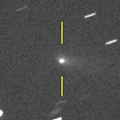
|
Now it is 16.4 mag (Oct. 30, Toshihiko Ikemura, Hirohisa Sato). It stays observable in good condition while the comet will be fading slowly after this.
Date(TT) R.A. (2000) Decl. Delta r Elong. m1 Best Time(A, h)
Nov. 16 3 18.53 -1 35.0 1.705 2.656 159 16.9 23:37 ( 0, 53)
Nov. 23 3 15.14 -1 54.8 1.773 2.706 156 17.1 23:06 ( 0, 53)
|
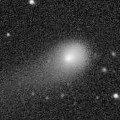
|
Fading. Now it is 17.3 mag (Nov. 1, Toshihiko Ikemura, Hirohisa Sato). It stays 17 mag from autumn to winter. It is observable in good condition in the Northern Hemisphere. It locates low in the Southern Hemisphere.
Date(TT) R.A. (2000) Decl. Delta r Elong. m1 Best Time(A, h)
Nov. 16 9 15.41 23 42.0 6.261 6.488 98 16.9 5:07 (328, 77)
Nov. 23 9 12.58 23 40.0 6.182 6.532 106 16.9 5:07 ( 0, 79)
|
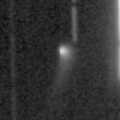
|
Now it is 17.7 mag (Oct. 31, Toshihiko Ikemura, Hirohisa Sato). It will be fading after this. In the Northern Hemisphere, it stays observable in good condition for a long time. In the Southern Hemisphere, it stays extremely low for a long time.
Date(TT) R.A. (2000) Decl. Delta r Elong. m1 Best Time(A, h)
Nov. 16 1 38.70 39 46.6 3.451 4.330 149 17.1 21:57 (180, 85)
Nov. 23 1 28.13 37 39.9 3.530 4.370 144 17.1 21:19 (180, 87)
|
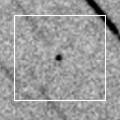
|
Now it is 16.7 mag (Aug. 9. Grorudalen Optical Observatory). It passed the perihelion on July 2. Then it must have brightened up to 13 mag, but it was not observable around that time. In the Northern Hemisphere, it stays observable in excellent condition until December when it becomes fainter than 18 mag. In the Southern Hemisphere, it stays locating low.
Date(TT) R.A. (2000) Decl. Delta r Elong. m1 Best Time(A, h)
Nov. 16 0 27.62 35 56.5 1.178 2.023 137 17.2 20:47 (180, 89)
Nov. 23 0 20.99 32 47.9 1.273 2.066 131 17.4 20:13 ( 0, 88)
|

|
Fading now. Now it is 17.1 mag (Oct. 5, M. Masek). In the Southern Hemisphere, it stays observable for a long time until it fades out. In the Northern Hemisphere, it will not be observable after this.
Date(TT) R.A. (2000) Decl. Delta r Elong. m1 Best Time(A, h)
Nov. 16 6 7.77 -52 33.4 5.126 5.393 100 17.3 2:30 ( 0, 2)
Nov. 23 5 57.83 -53 40.9 5.165 5.446 101 17.4 1:53 ( 0, 1)
|
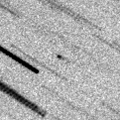
|
First return of a new periodic comet which brightened up to 18 mag in 2014. Now it is 17.2 mag (Nov. 1, Toshihiko Ikemura, Hirohisa Sato). It stays 17 mag until November. It is observable in good condition in the Northern Hemisphere. It locates extremely low in the Southern Hemisphere.
Date(TT) R.A. (2000) Decl. Delta r Elong. m1 Best Time(A, h)
Nov. 16 8 5.51 43 52.3 0.374 1.204 116 17.4 4:28 (180, 81)
Nov. 23 8 11.10 43 57.6 0.390 1.238 121 17.5 4:06 (180, 81)
|
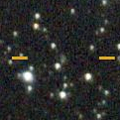
|
Now it is 17.3 mag (Oct. 26, Toshihiko Ikemura, Hirohisa Sato). It will brighten up to 12 mag in winter in 2022.
Date(TT) R.A. (2000) Decl. Delta r Elong. m1 Best Time(A, h)
Nov. 16 22 1.59 43 32.9 7.051 7.441 109 17.5 18:21 (180, 81)
Nov. 23 22 2.41 43 0.1 7.071 7.396 105 17.4 18:19 (152, 81)
|
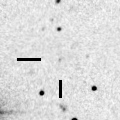
|
Now it is 17.4 mag (Oct. 31, Ken-ichi Kadota). It is observable at 17-18 mag for a long time from late 2019 to early 2021. It will fade out before it passes the perihelion.
Date(TT) R.A. (2000) Decl. Delta r Elong. m1 Best Time(A, h)
Nov. 16 3 10.56 0 38.2 4.225 5.174 161 17.5 23:29 ( 0, 56)
Nov. 23 3 6.88 0 34.8 4.234 5.160 157 17.5 22:58 ( 0, 56)
|
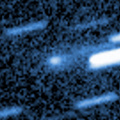
|
It brightened up to 16 mag in September. Now it is fading. Now it is 17.1 mag (Nov. 1, Toshihiko Ikemura, Hirohisa Sato). It will be fainter than 18 mag in December.
Date(TT) R.A. (2000) Decl. Delta r Elong. m1 Best Time(A, h)
Nov. 16 10 22.54 3 43.1 1.444 1.557 77 17.7 5:07 (319, 51)
Nov. 23 10 33.28 1 48.9 1.434 1.608 80 17.9 5:13 (328, 52)
|
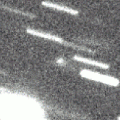
|
Now it is 17.8 mag (Nov. 2, Toshihiko Ikemura, Hirohisa Sato). It was exptected to brighten up to 16.5 mag from October to December. But actually, it is fainter than originally expected. It seems to brighten up to 18 mag at best. It is observable in good condition in the Northern Hemisphere. It locates low in the Southern Hemisphere.
Date(TT) R.A. (2000) Decl. Delta r Elong. m1 Best Time(A, h)
Nov. 16 9 9.50 26 0.1 1.108 1.618 100 17.8 5:07 (329, 79)
Nov. 23 9 25.86 28 35.8 1.065 1.628 104 17.8 5:13 (346, 83)
|
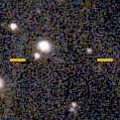
|
Now it is 17.9 mag (Oct. 29, Toshihiko Ikemura, Hirohisa Sato). It is observable at 18 mag in good condition in winter. It locates somewhat low in the Southern Hemisphere.
Date(TT) R.A. (2000) Decl. Delta r Elong. m1 Best Time(A, h)
Nov. 16 4 24.45 24 44.1 2.290 3.254 164 17.9 0:48 ( 0, 80)
Nov. 23 4 19.73 24 30.8 2.266 3.247 172 17.8 0:15 ( 0, 80)
|
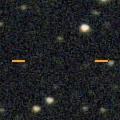
|
Now it is very faint as 19.7 mag (Oct. 25, Toshihiko Ikemura, Hirohisa Sato). It brightened up to 15.5 mag in 1997, and 17 mag in 2008, however, it is much fainter in this apparition.
Date(TT) R.A. (2000) Decl. Delta r Elong. m1 Best Time(A, h)
Nov. 16 1 6.76 14 37.6 2.477 3.351 147 20.2 21:26 ( 0, 70)
Nov. 23 1 5.48 13 57.8 2.542 3.358 139 20.3 20:57 ( 0, 69)
|
|
![]()
 101P/Chernykh
101P/Chernykh C/2018 F4 ( PanSTARRS )
C/2018 F4 ( PanSTARRS ) C/2017 M4 ( ATLAS )
C/2017 M4 ( ATLAS ) C/2018 DO4 ( Lemmon )
C/2018 DO4 ( Lemmon ) C/2017 K2 ( PanSTARRS )
C/2017 K2 ( PanSTARRS ) 289P/Blanpain
289P/Blanpain C/2019 K7 ( Smith )
C/2019 K7 ( Smith ) 246P/NEAT
246P/NEAT A/2017 U7
A/2017 U7 C/2019 N1 ( ATLAS )
C/2019 N1 ( ATLAS ) 261P/Larson
261P/Larson C/2010 U3 ( Boattini )
C/2010 U3 ( Boattini ) C/2019 K5 ( Young )
C/2019 K5 ( Young ) C/2015 O1 ( PanSTARRS )
C/2015 O1 ( PanSTARRS ) C/2018 A3 ( ATLAS )
C/2018 A3 ( ATLAS ) (3200) Phaethon
(3200) Phaethon C/2016 N6 ( PanSTARRS )
C/2016 N6 ( PanSTARRS ) 384P/2019 O1 ( Kowalski )
384P/2019 O1 ( Kowalski ) C/2019 L3 ( ATLAS )
C/2019 L3 ( ATLAS ) 173P/Mueller 5
173P/Mueller 5 387P/2019 R1 ( Boattini )
387P/2019 R1 ( Boattini ) 76P/West-Kohoutek-Ikemura
76P/West-Kohoutek-Ikemura 203P/Korlevic
203P/Korlevic 200P/Larsen
200P/Larsen![]()





































